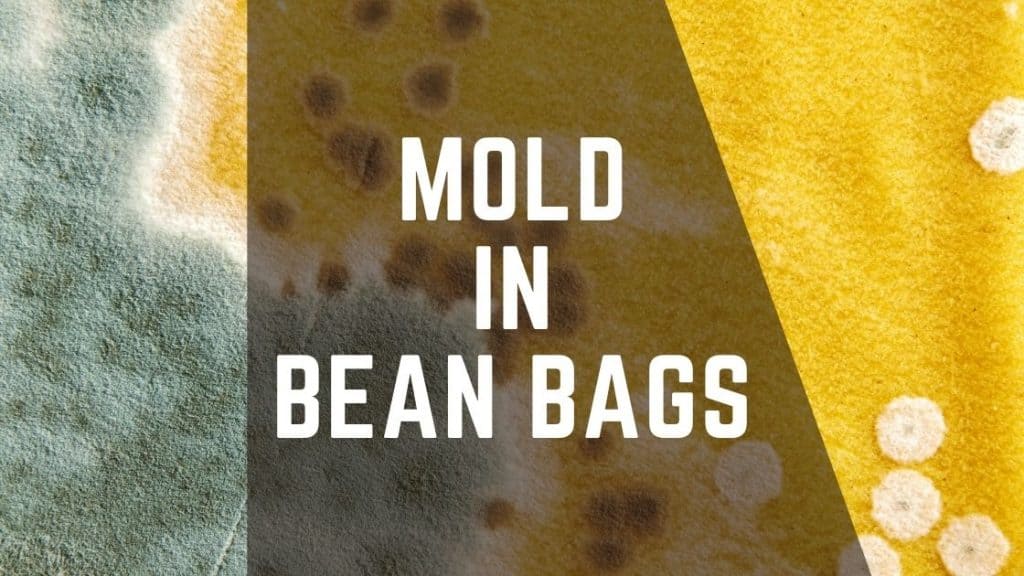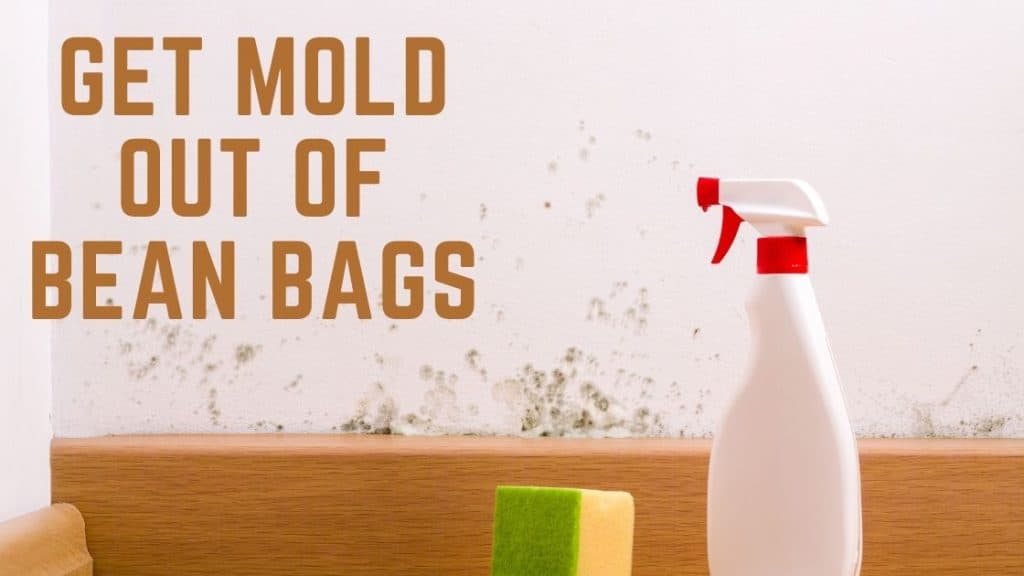Mold in Bean Bags – Everything you Need to Know
If you have a bean bag, you should know how to maintain it properly. If not, bean bags may be susceptible to mold and mildew.
Mold is a significant issue for bean bags, mainly associated with outdoor bean bags. The bean bag owners experience bad smells and discoloration because bean bags can get moldy.
Other than these physical issues, mold can badly influence human health. If you inhale them, it will affect your respiratory process. Also, the molds can generate heart problems, joint pain, migraines, and even symptoms like depression.
Therefore, do not lay down bean bags that dirt with molds. Because some molds emit toxic gases, and they can be inhaled into your body.
So, this article mainly answers how molds incorporate with bean bags and how to get rid of them. First of all, let’s see why bean bags are infected with mold.

Table of Contents
- Why do the Mold and Mildew Grow in Bean Bags?
- Get Mold and Mildew Out of Bean Bags
- How to Clean Moldy Bean Bags?
- Natural Methods to Get Rid of Mold and Mildews in Bean Bags
- Final Words
Why do the Mold and Mildew Grow in Bean Bags?
Generally, mold and mildews are common fungi that grow on wet surfaces rich with moisture.
Mildew is generally white, grey, or yellow fungi type. It grows on moist bean bag surfaces. Moreover, sometimes mildew varieties look like cotton wool or powdery foam.
On the other hand, if your bean bag is dirt with molds, these areas tend to be dark green or black. Also, molds have fuzzy or slimy textures.
Before getting rid of these fungi, you have to identify why mold grows in a bean bag. Let’s see the primary reasons.
Reason 1: Bean Bag Placed in Warm, But Moist Environment
If you placed your bean bag near a window or balcony, the mist and rain could quickly contact your bean bag. Also, some places, such as nearby pools and outdoor areas, are highly humid. If you place your bean bag near these areas, it can get wet with moist.
However, if these moist not evaporate soon, it becomes an ideal environment for mold growth.
Reason 2: Some Bean Bag Fabrics and Fillers are Highly Susceptible to Fungi
Generally, most bean bag fabrics and fillers absorb moisture. Think about a leather bean bag. Leather is a natural fabric made with animal skin. Thus, if it is wet and not dry well, mold can quickly grow in there.
Not only leather but also fabric like cotton, velvet, and linen can highly absorb water. The fillers like shredded memory foam and cotton also easily absorb water. After these materials get wet, they will create a suitable environment for mold growth.
Reason 3: Mold Growing in Wooden or Carpet Floor can Spread into Bean Bags.
If you place your bean bag on a wet surface or surface infected with mold, it can spread over the bean bag.
Reason 4: Bean Bag Dirt with Oil and Other Liquids
How many times have you spilled your cup of tea on a bean bag? Yes, it is also a reason for mold growth. Some liquids such as oil, wine, coffee, and tea provide ideal growth media for fungi.
Not only spilled liquid, but our skin is also rich with oil and sweat. So, over time bean bags contaminate them and cause the growth of molds.
These are general reasons for mold growth. However, you can prevent some reason before your bean bag gets infected with mold.
But some of these reasons are inevitable. Therefore, you have to follow the proper method to get rid of them. Let’s see how to get rid of mold.
Get Mold and Mildew Out of Bean Bags
Here, you can follow bit different processes for mildew and molds. It means you can more easily handle mildew than mold. And also, mildew issues won’t be any lasting issues.
But when we consider mold, it is not easy to handle because you should have to follow some safety measures to avoid any further health complications.
However, when you handle mold and mildew, wear a face mask. It will block the inhaling fungi parts into the respiratory tract.
Using Mold and Mildew Cleaner
Step 1: Take mildew cleaner and apply it to affected areas
Step 2: Smoothly rub that area using a scrubbing brush
Step 3: Finally, remove the waste using a dump cloth
Step 4: Let bean bag dry under sunlight
Expose to Direct Sunlight
Sunlight is the best natural source to eliminate the effect of fungi. It can dehydrate fungi cells and destroy them. Also, its heat can evaporate and reduce the moisture level of your bean bag.
Not only the bean bag but the location where you placed your bean bag rich with fungi, you need to expose that area to direct sunlight.
Some manufacturers do not allow to exposure of bean bags under direct sunlight. Thus, read manufacture guidelines first. However, you can practice the sun drying process under bit shaded areas such as under the tree.
Sometimes you are unable to deal with the molds that have begun growing on the bean bag. Like other soft furniture, bean bags also have a lifespan. Thus, if you cannot clean mold by yourself or by an expert, it is time to replace your bean bag.

How to Clean Moldy Bean Bags?
Mold presents a black or green spot discoloration with a bad smell, making it easier to identify. However, these small fungi colonies can ruin the pleasant feeling of your bean bag.
Also, once mold goes through the bean bag fabric cover, it will be challenging to eliminate. Then it will become a severe problem. It also causes to begun some health hazards such as allergies or asthma. Moreover, some molds are toxic.
Therefore, to conquer mold, practice below mold removal tips.
Step 1: Remove the outer cover of the bean bag
Step 2: Mix mild detergent in hot water
Step 3: Add oxygenated bleach into the above mixture according to the manufacturer’s instructions
Some people use chlorine bleach to get rid of mold from hard surfaces like floors and walls. But here, you cannot use them for bean bags. This chemical can fade bean bag fabric and burn it.
Thus, do not directly use chlorine bleach or other mold-removing chemicals that contain chlorine bleach for your bean bag.
The safer alternative is oxygenated bleach.
If mold penetrates to the inner cover, you have to clean them too.
Natural Methods to Get Rid of Mold and Mildews in Bean Bags
However, if you are not comfortable with chemicals, you can use the below-mentioned natural methods to get rid of mildew and molds. Try them!
Using White Vinegar
Step 1: Take distilled vinegar and spray it onto moldy areas of your bean bag
White vinegar is a weak nontoxic acid that can kill 82% of mold species. Also, it has no dangerous fumes.
Step 2: Leave it for one hour.
Step 3: Then wipe that area using a wet dump cloth
Step 4: Allow the bean bag to dry
The smell of the vinegar will go away within several hours.
Using White Tea Tree Oil
Tea tree oil is an effective element that can kill fungus and bacteria. Use it according to the below guideline.
Step 1: Add one teaspoon of tea tree oil to a cup of water
Step 2: Spray it directly onto the mold using a spray bottle
Here, you don’t need to rinse it. The tea tree oil smell may remain for a few days. However, that smell is pleasant for most people.
Using White Grapefruit Seed Extract
The grapefruit seed extract is an odorless solution that can remove mold from the fabric. It includes citric acid, and that amount is fatal to mold.
Step 1: Add ten drops of grapefruit seed extract to a cup of water
Step 2: Fill this solution on the spray bottle and shake well
Step 3: Apply it directly to moldy areas
Here also, it is not required to rinse. The remaining extract will continue to treat mold. It helps prevent the appearance of molds again.
Final Words
Mildew and mold can give health effects like skin allergies, coughing, headaches, and breathing problems. It also can emit smell and reduce the appearance of the bean bag. These can badly affect especially kids and toddlers.
Thus, it is vital to clean molds immediately. However, to protect your bean bag, you have to follow specific methods. I hope now you have a better understanding of how to clean mold and mildew from bean bags. Try them and recover your bean bag as a new one!




